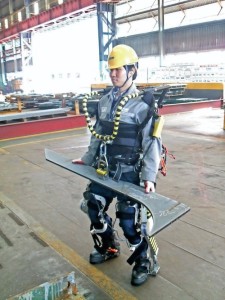Photo courtesy of Daewoo
Physical interaction involves a tool that engages the user in a back and forth like a good conversation. Instead of a person simply listening to a friend complain constantly, a great interaction involves both parties participating equally. The technology version of said conversation is not only triggered once by the user, but rather ping pongs the experience, reacting to each new desire as it arises and continues to interact throughout the process. A great example I read about a year ago is the Daewoo robotic exoskeleton for dockworkers. The image is directly out of ALIENS. Remember when Ripley battles the alien in this giant metal suit that makes her a gazillion times stronger? Now it exists in real life. The wearer can lift 30 kilograms with the help of the suit and still walk at a normal pace. It is the type of technology that would make Bret Victor proud. The suit allows the use of human physicality only it enhances it beyond our normal limited capabilities. It is really an impressive feat in making science fiction into a great interactive reality.
However, there are other things posing as interactive that I think are terrible examples of it. I absolutely loathe the “choose your own adventure” version of filmmaking and virtual reality. I read those books as a kid and they were dreadful. The reader quickly figures out that there is really only one option for the story to unfold in a remotely entertaining way. This fails to me on true interactivity because I believe the interaction needs to enhance the experience, not simply be interactive for interaction’s sake. Great storytelling transports the reader to another place and time. The person experiencing the story should not also be authoring it or it counters the enjoyment of the ride. The interactive aspect of the technology should enhance this ride, not weaken it. The interactive version might find the user spending more time on backstory or spending more time with a particular character or even choosing to explore a location longer than another person might. It could contain an interactive emotional element, an artificial intelligence if need be that gets to know the personality of the user helping to elevate the experience, but it should not simply be the tech version of the old “choose your own adventure” novel. That is hardly reinventing the wheel and most definitely not good interactivity.


Hey Jamie,
I completely agree that the “choose your own adventure” model is flat and uninteresting. I was wondering what you think of online worlds like World of Warcraft and Second Life. I don’t have much first hand experience with either but from what I’ve seen it seems like both problematize that kind of linear interaction. Users create their own avatars, but perhaps because of the sheer amount of other users hanging around, they’re not as in control as they perceive? The idea of an interaction as an “adventure” is interesting to me, and I wonder how that could be applied outside of the context of gaming.